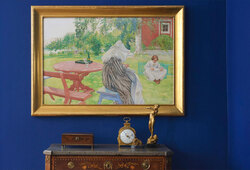Jean-Paul Riopelle
JEAN-PAUL RIOPELLE, colour lithographe, from Derrière le Miroir nr 171, 1968.
Composition. S. 38 x 55 cm.
Not examined out of frame. Center crease.
Artist
– Riopelle succeeds where memory fails. The intangible is given a body, desire a pictorial life. Objects astray, discarded impressions, forgotten emotions are put together in a cocktail-shaker and are poured out on the rocks in a Venetian glass of exquisite transparency in a splendid explosion.” (P. Boudreau, foreword, exhibition catalogue, Riopelle, London 1959)
French-Canadian artist Riopelle exhibited at the “Véhemences Confrontées” exhibition in 1951. The title roughly means “opposing forces” and is an apt one for this powerful individualist. Riopelle moved to Paris in 1947 where he came into contact with the Surrealism movement, although he deliberately did not join it. With his North American heritage, it is easy to draw parallels with American abstract expressionists such as Willem de Kooning and Jackson Pollock but Riopelle distanced himself from these movements too. His art is not intended to be rational or representational but is derived from an autonomous process that goes beyond the conscious, sometimes termed lyrical abstraction.
In the early 1950s Riopelle started to experiment by dropping and throwing oil paint on canvas. He developed this technique to eventually apply the paint with a palette knife in thick, very distinct fields of colour with a very impasto, sculptural surface.
In the 1950s Riopelle also made an international breakthrough, exhibiting at the Sao Paolo Biennial, Guggenheim NY and the Venice Biennale.
Read more

























